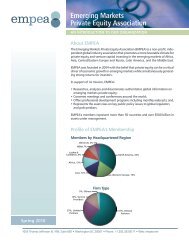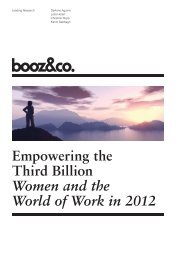Top 100 - Wamda.com
Top 100 - Wamda.com
Top 100 - Wamda.com
- No tags were found...
You also want an ePaper? Increase the reach of your titles
YUMPU automatically turns print PDFs into web optimized ePapers that Google loves.
BrandZ <strong>Top</strong> <strong>100</strong> 2011: SECTORS/COMMENTARY 60LuxuryIf you’ve got it, enjoy it!Luxury came back, without apology.Although consumers in North America and Europecontinued to reject conspicuous consumption, thosewho could afford the most exclusive shops no longereschewed the shopping bags that proclaimed theirgood fortune.The new ethos frowned on flaunting and encouragedawareness of how one’s purchases, whether diamondsfrom African mines or apparel stitched in Asian factories,impacted the environment and people all along thesupply chain.Connected to the concern with a product’s origins wasa deepened appreciation for the craftsmanship that wentinto its creation. In a world of mass-produced consumergoods, bespoke attention to individuality became theultimate luxury. And it provided a rational reason – ifneeded – for justifying an emotional, expensive purchase.Many brands raised prices. Those that genuinely couldclaim a history of design leadership and customizationcapitalized on their brand heritage in advertising and inonline and in-store presentations. Gucci turned areas ofsome of its stores into small workshops where customerscould view leatherworkers crafting handbags.To attract a new generation of shoppers,Louis Vuitton launched a program toencourage young artists with publicityand financial support, while continuingto evoke its heritage in travel to preserverelationships with the brand’s traditionalfollowing. Louis Vuitton remainedthe highest-valued luxury brand andincreased in value by 23 percent.Louis Vuitton broadcast its London fashion show onYouTube, an indication of the industry effort to be morecontemporary in both product and <strong>com</strong>munication.Burberry sent personalized messages to the mobilephones of customers, inviting them to view the brand’sLondon fashion show streamed live to a Burberry store.Any item from the catwalk could be purchased fordelivery within weeks. Burberry continued to successfullyrejuvenate the 155-year-old British heritage brand andenjoyed year-on-year double-digit increases inall markets.Chanel entered e-<strong>com</strong>merce for the first time, althoughmore for the sale of accessories than couture, becauseextending luxury credentials to the mass market riskeddiluting the exclusivity of the brand. Brands thatprotected their exclusivity – such as Chanel, Hermès, orCartier – were better insulated from the recession thanmore accessible luxury brands. The Hermès brand valuegrew 41 percent.Hermès launched a Chinese brand that may herald theinception of luxury brands developed in fast-growingmarkets. Meanwhile, China and other BRIC countriesremained important markets because badge statusgratified a growing middle class and a band of affluentindividuals who had wealth for the first time and wereready to spend it.TOPBRANDSBrand Value$MBrandContributionBrandMomentumBrand ValueChange1 Louis Vuitton 24,312 5 7 23%2 Hermès 11,917 5 8 41%3 Gucci 7,449 5 4 -2%4 Chanel 6,823 5 9 23%5 Cartier 5,327 5 6 34%6 Rolex 5,269 5 5 11%7 Hennessy 4,997 5 8 -7%8 Moët & Chandon 4,570 5 8 7%9 Fendi 3,422 5 5 7%10 Burberry 3,379 4 7 N/ASource: Millward Brown Optimor(including data from BrandZ and Bloomberg)LUXURYUP 19%
















